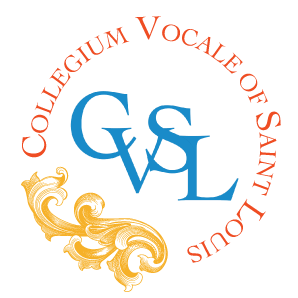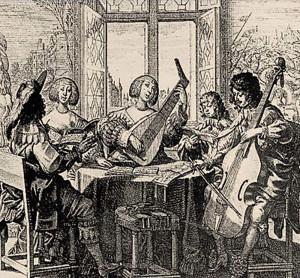Johann Sebastian Bach (1685-1750) is universally regarded as one of the supreme masters of Western music history. His compositions are well known for their technical mastery and emotional complexity. Bach composed in nearly all of the available musical styles and genres of his day except for opera, and that was due only to a lack of opportunity. As one of the defining composers of the Baroque Period, his large-scale vocal works, such as the B Minor Mass, the Passions of St. Matthew and St. John, and the Christmas Oratorio are well known. Less familiar are the delights of most of his church cantatas. It is the aim of today’s program to provide you with the opportunity to experience a few of these splendid, but less familiar cantatas.
Born into a musical family at Eisenach, Germany, Bach received a thorough training that included exposure to music of the most important German, French, and Italian composers of his day. He exhibited exceptional skill as an organist and his first professional position was as the organist at St. Boniface’s in Arnstadt beginning in 1703. It was during this period that Bach made the 250 mile trip to Lübeck, where he spent three months visiting the great organist and composer, Dietrich Buxtehude.
Dissatisfied with the conditions at Arnstadt, Bach accepted a position in 1706 at St. Blasius’ church in Mühlhausen, where he met and married his first wife, Maria Barbara. Two years later, in 1708, Bach had the opportunity to accept a position as organist and concertmaster at the ducal court in Weimar. He spent the next nine years playing and composing chiefly keyboard and instrumental music, but also composed a few sacred cantatas. Most of his other 200 surviving cantatas were composed while Bach was at Leipzig (1723-1750) where his duties required that he produce a cantata a week.
The title of this concert, “Faith in the Time of Tribulation,” represents the struggle of the soul to maintain its faith in God and in Jesus in spite of life’s trials and the fear of suffering and death. This theme runs through many of Bach’s sacred works, but seemed to be particularly characteristic of this selection of cantatas. In all his sacred works, Bach’s personal faith allows him to express, with great immediacy, a persistent longing for God’s presence and an abiding trust in God’s protection through life’s trials and a fierce determination to abide with Jesus throughout his life. It is this undercurrent of Bach’s own faith that allows this music to speak so clearly to listeners of every age and faith.
We know from written records that Bach composed five cycles of cantatas for the liturgical year, but, sadly, most of these are lost. Of the ones that remain, perhaps the most significant ones are those composed for the years 1724-1725. Here Bach refined the previously existing ‘chorale cantata,’ that is, a cantata in which the first and last movements are based on the first and last stanzas of the hymn text and the inner movements are based on paraphrases of the inner stanzas, providing the necessary freedom for expansion on the themes and emotions inherent in the chosen text.
Mache dich, mein Geist, bereit, BWV 115, a chorale cantata, is written for four voices, flute, oboe d’amore, two violins, viola, bassoon, cello, and organ. It was first performed on the 22nd Sunday after Trinity on November 5, 1724. It sets forth the theme of the Soul’s duty to be watchful and to resist the world’s temptations. The opening movement is a chorale prelude, which features a statement of the chorale, the anonymous 1681 folk dance melody, “Straf mich nicht in deinem Zorn” (Do not punish me in your anger) within the context of an elaborate instrumental texture. The alto aria that follows is set as a gentle lullaby depicting the sleeping soul that is suddenly awakened by a punishing Angel of Death. The aria closes with a return to its gentler opening mood and a suggestion of the Eternal Sleep of the Soul. The bass recitative assures us that God watches over us, but expects us to be equally watchful and to resist the world’s temptations. The soprano aria, featuring the flute and violincello piccolo, underlines this sense of the Soul’s prayerful watchfulness.
Mein Gott, wie lang, ach lange?, BWV 155 was composed for the Second Sunday of Epiphany and was originally performed in Weimar on January 19, 1716. Bach also performed it again in Leipzig on January 16, 1724. It is written for four voices, strings, bassoon, and organ. This intimate cantata encourages us to understand the joy one experiences when holding fast to Jesus and not fearing death. The opening accompanied recitative sets forth the anxiety and despair of the Soul, thinking that God has abandoned it. The following duet for alto and tenor, which emphasizes that the Soul must continue to hope and maintain faith despite whatever trials befall it, seems meant to quell any anxiety and despair. This duet is accompanied by a remarkable virtuoso bassoon obbligato, a feature rarely heard in Bach’s works. As in Cantata 115, the bass voice offers assurance and consolation in his recitative. The Soul’s response to this is expressed in the next enthusiastic soprano aria with strings. The cantata concludes with a confident chorale.
Wachet, betet, seid bereit allezeit, BWV 70, focuses on the determination to hold fast to Jesus, who will support the believer through all of life’s trials. It was composed for the 26th Sunday after Trinity and was first performed in Leipzig on November 21, 1723. Based on an earlier cantata from Bach’s Weimar period, it is written for trumpet, oboe, bassoon, strings, and organ. The opening movement exhorts the Soul to be watchful and ready for the Final Judgment, a sense that is evoked by the presence of the “Last Trumpet.” Throughout the remainder of the cantata, in a series of recitatives and arias, a mood of dreadful expectancy alternates with the assurance of faith in Jesus and the goodness of God. This appears in a particularly dramatic manner in the bass recitative and aria near the end of the cantata, where the bass asks if the end of the world should not awaken fear and trembling in all who contemplate it. As this text unfolds, amid the fury of the strings depicting the wrath and destruction of the world, the trumpet sounds forth the chorale tune, “Es ist gewisslich an der Zeit,” which would have been familiar to Bach’s congregation and would have brought to mind its text: “Indeed the time is here when God’s Son will come; then laughter will be rare, when everything goes up in flames.” This is truly a hair-raising moment in the piece, however the following bass aria assures us that Jesus will lead the faithful into a life of eternal peace. The cantata concludes with a verse of the hymn set in pure chorale style.
Thirty years ago, Joshua Rifkin jolted the musicological world with a thesis that Bach’s cantatas, passions, and oratorios were performed under his direction by a single singer on each part, instead of three or four, as many believed. This stirred a furious debate at the time and these discussions continue to this day. However, the evidence for this practice is quite convincing and the practice is becoming more widely accepted. While there is no question that performances of Bach’s cantatas and passions with choirs of 12, 24, or 100 or more singers are tremendously moving and inspirational, we believe that there is much to be gained from the more intimate approach that is the result of performing these pieces with only one singer or player to a part. Not only does this practice reflect the experience of Bach’s original audience, but the resulting musical texture offers greater clarity in the interplay of the voices and instruments and enlivens the music-making among the participants by bringing the music to a more personal and individual level.
It was the practice in Bach’s day to perform a cantata both before and after the sermon, a practice clearly seen in Cantata 70, which is composed in two parts. We will present one of the readings prescribed for the 26th Sunday after Trinity between Parts One and Two in place of a sermon.
Several of the instruments heard on today’s program may be unfamiliar to you. The oboe d’amore, featured in Cantata 115, was a uniquely German instrument, despite the fact that in Bach’s day it was most often called hautbois d’amour. It is not known how this instrument came to be called “d’amore.” It was developed sometime around 1710, most likely in Leipzig, by local players and instrument makers. The oboe d’amore had a relatively short life in the eighteenth century. Bruce Haynes states that two-thirds of the repertory of the oboe d’amore was composed between 1717-1730, most of the remaining third between 1730 and 1760, and less than two percent after 1760. The instrument was revived in a modern form later in the 19th century, appearing in Verdi’s Aida and works of Richard Strauss, Ravel, and others. The oboe d’amore is pitched a minor third lower than the regular oboe, which allows it to play more easily in keys that would otherwise be highly problematic. Its distinctive sound, darker and richer than the higher oboe, makes it a wonderful solo instrument.
Bach used the ‘violoncello piccolo‘ in nine cantatas, always as a solo instrument. There is some discussion in musicological circles about what exactly this instrument was. One of the possibilities is the viola da spalla, the ‘shoulder viola’ heard on today’s program. Halfway in size between a regular cello and a viola, it was played while holding it on the shoulder, often with a ribbon or strap to help hold it in place. Developed in Italy, it may have been used by violinists to play bass lines when other instruments were not available. In recent years, Sigiswald Kuijken, one of today’s pre-eminent Baroque violinists has become the modern champion of the violincello da spalla, a similar instrument, and has recorded Bach’s Suites for Solo Cello on it.
One of our principal goals in presenting our concerts is to bring to our listeners an enhanced musical experience, through our programming of little-heard music in as an historically informed manner as possible, and through the use of appropriate instruments. It is our heartfelt hope that our performances will open an exciting new world of sonorities and sensibilities to you, our listeners and supporters.
© Dr. Bruce Carvell, February 2014

